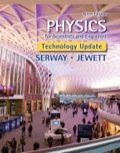
(i)
The current present in the region of space between the plates of the capacitor during the discharging of the R C
(i)
Answer to Problem 34.1QQ
Explanation of Solution
During the discharging of
Conclusion:
Since, the displacement current is represented by the time varying electric flux and there is no conductor between the plates. Thus, option (b) is correct.
As there is no conductor presents between the capacitor plates, there is no conduction current but the displacement current is present. Thus, option (a) is incorrect.
The displacement current is present but the conduction current is not presents between the plates so it is impossible to present both the currents between the plates. Thus, option (c) is incorrect.
As there is displacement current is present between the plates so it is not correct that there is no current of any type. Thus option (d) is incorrect.
(ii)
The field present in the region of space between the plates of the capacitor during the discharging of the R C
(ii)
Answer to Problem 34.1QQ
Explanation of Solution
When a capacitor is fully charged after opening the circuit, after some time it starts to discharge. Due to the discharging of the capacitor there is only electric field is present.
After the some time when the discharging of the capacitor plates take place, the charge particle starts to move from one plate to another plate. This movement of the charge particle creates a magnetic field at the plate. So after discharge of a capacitor plate there is both electric and magnetic fields are present.
Conclusion:
Since, after the discharging of the capacitor plate there is electric field and magnetic field both are present. Thus, option (c) is correct.
As the magnetic field is also present with the electric field then there is no scope that there is no magnetic field. Thus, option (a) is incorrect.
As the electric field is present with the magnetic field then there is no scope that there is no electric field. Thus, option (b) is incorrect.
As the electric field and the magnetic field both are present it is not possible that there is a absence of any field. Thus, option (d) is incorrect.
Want to see more full solutions like this?
- The potential difference V(t) between parallel plates shown above is instantaneously increasing at a rate of 107V/s. What is the displacement current between the plates if the separation of the plates is 1.00 cm and they have an area of 0.200m2?arrow_forwardA potential difference V(t) = V0sin tis maintained across a parallel-plate capacitor with capacitance C consisting of two circular parallel plates. A thin wire with resistance R connects the centers of the two plates, allowing charge to leak between plates while they are charging. (a) Obtain expressions for the leakage current Ires(t) in the thin wire. Use these results to obtain an expression for the current Ireal(t) in the wires connected to the capacitor. (b) Find the displacement current in the space between the plates from the changing electric field between the plates. (c) Compare Ireal(t) with the sum of the displacement current Id(t)and resistor current Ires(t) between the plates, and explain why the relationship you observe would be expected.arrow_forwardIn a region of space, the electric field is pointed along the x-axis, but its magnitude changes as described by Ex=(10N/C)sin(20x500t)Ey=Ez=0 where t is in nanoseconds and x is in cm. Find the displacement current through a circle of radius 3 cm in the x = 0 plane at I = 0.arrow_forward
- A parallel-plate capacitor with circular plates of radius R is being discharged. The displacement current through a central circular area, parallel to the plates and with radius R/2, is 2.0 A.What is the discharging current?arrow_forwardA parallel-plate capacitor with circular plates of radius R is being charged. Show that the magnitude of the current density of the displacement current is Jd = e ´0(dE/dt) for r <-R.arrow_forwardA 0.120- A current is charging a capacitor that has square plates 5.80 cm on each side. The plate separation is 4.00 mm A) Find the time rate of change of electric flux between the plates V*m/s B) Find the displacement current between the plates Aarrow_forward
- Calculate the displacement current Id between the square plates, 7.2 cmon a side, of a capacitor if the electric field is changing at a rate of 2.8×10^6 V/m*s Id=arrow_forwardAn electric potential v(t)= 100 cos(36000pt) is established between two infinite parallel plates which are separated from each other by 1 cm. Find the displacement current in the space between the plates if it is filled with(a) air,(b) a dielectric material with er=100.arrow_forwardProve that the displacement current in a parallel-plate capacitor of capacitance C can be written as id =C(dV/dt), where V is the potential difference between the plates.arrow_forward
 Principles of Physics: A Calculus-Based TextPhysicsISBN:9781133104261Author:Raymond A. Serway, John W. JewettPublisher:Cengage Learning
Principles of Physics: A Calculus-Based TextPhysicsISBN:9781133104261Author:Raymond A. Serway, John W. JewettPublisher:Cengage Learning

